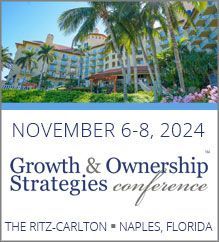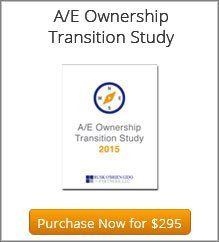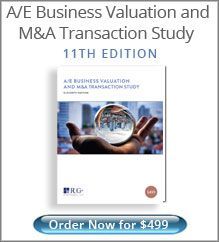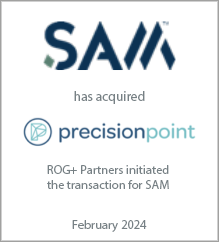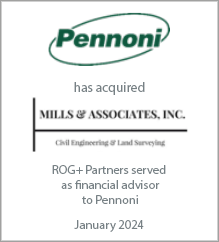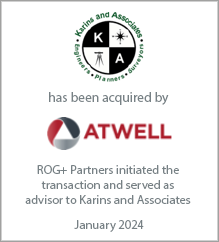Michael S. O'Brien is a principal in the Washington, DC office of Rusk O'Brien Gido + Partners. He specializes in corporate financial advisory services including business valuation, fairness and solvency opinions, mergers and acquisitions, internal ownership transition consulting, ESOPs, and strategic planning. Michael has consulted hundreds of architecture, engineering, environmental and construction companies across the U.S. and abroad.
Does the valuation of your company’s stock reflect ALL of its risk?
Does the valuation of your company’s stock reflect ALL of its risk?
January 22, 2014
Whether a business valuation is done for purposes of transferring ownership internally from one employee to another, or for meeting the regulatory requirements of sponsoring an employee stock ownership plan, the risk associated with such an investment is a critical element in determining its value.
So, what is risk? Oftentimes, an appraiser will look at risk from a business operating point of view. When valuing a closely held firm operating in the A/E industry, we look for risk in areas such as key personnel, customer concentrations, markets served, and geographic concentrations – just to name a few. Aside from these, another area of risk to which we’ve been paying much closer attention lately is stock redemption obligation risk. This risk is often accounted for in the discount for lack of marketability.
If your firm receives an annual valuation of its common shares from an accredited business appraiser, then you will be familiar with the discount for lack of marketability. This is the discount rate that is applied to the underlying security being valued to account for its illiquidity. In a closely held company, the transfer of shares is often restricted by the terms of a shareholders’ agreement. Often, shareholders in such firms may only sell their stock under certain circumstances and only to certain buyers– typically other employees and/ or the company. The discount that is applied to account for this illiquidity is determined by many factors, but the most common factors that are considered include; company characteristics such as size, performance, and operating risk; restrictive transfer provisions; dividend payments; rights to sell shares back to the company (“put rights”); information access and reliability; and attractiveness of the industry or company to investors. But because of recent trends in the industry, these factors alone may no longer fully account for illiquidity.
Since the recession, many A/E and environmental consulting firms have postponed their ownership transition plans because their values have fallen, and retiring shareholders have been unwilling to sell at a depressed value. The resulting delay in transitioning ownership has increased the shareholder repurchase obligation risk at many firms because there are more people closer to retirement today than there were in 2008. Most shareholder agreements stipulate that either the company or its remaining shareholders will repurchase the shares of retiring shareholders. Either way, the company must make available adequate cash flow to fund these obligations. Competing for this cash flow is the need to reinvest in working capital and fixed assets as the firm grows. The potential strain on cash flow has the potential to impair the liquidity of the company’s stock, and must be carefully examined by the appraiser and management alike.
Below are the key forces that compete for a firm’s cash flow, and therefore impact its value:
Over the past two years, we have seen more firms shift their cash flow allocation to improving shareholder liquidity, but this has come at the expense of allocating cash flow to incentive compensation. The valuation of your company must consider not only the liquidity risk of the shares, but the risk of not being able to invest in growth because of increasing cash flow demand for shareholder repurchase obligations. Reviewing your shareholder and employee demographics should be considered when understanding the risk of owning stock in your company.
So, what is risk? Oftentimes, an appraiser will look at risk from a business operating point of view. When valuing a closely held firm operating in the A/E industry, we look for risk in areas such as key personnel, customer concentrations, markets served, and geographic concentrations – just to name a few. Aside from these, another area of risk to which we’ve been paying much closer attention lately is stock redemption obligation risk. This risk is often accounted for in the discount for lack of marketability.
If your firm receives an annual valuation of its common shares from an accredited business appraiser, then you will be familiar with the discount for lack of marketability. This is the discount rate that is applied to the underlying security being valued to account for its illiquidity. In a closely held company, the transfer of shares is often restricted by the terms of a shareholders’ agreement. Often, shareholders in such firms may only sell their stock under certain circumstances and only to certain buyers– typically other employees and/ or the company. The discount that is applied to account for this illiquidity is determined by many factors, but the most common factors that are considered include; company characteristics such as size, performance, and operating risk; restrictive transfer provisions; dividend payments; rights to sell shares back to the company (“put rights”); information access and reliability; and attractiveness of the industry or company to investors. But because of recent trends in the industry, these factors alone may no longer fully account for illiquidity.
Since the recession, many A/E and environmental consulting firms have postponed their ownership transition plans because their values have fallen, and retiring shareholders have been unwilling to sell at a depressed value. The resulting delay in transitioning ownership has increased the shareholder repurchase obligation risk at many firms because there are more people closer to retirement today than there were in 2008. Most shareholder agreements stipulate that either the company or its remaining shareholders will repurchase the shares of retiring shareholders. Either way, the company must make available adequate cash flow to fund these obligations. Competing for this cash flow is the need to reinvest in working capital and fixed assets as the firm grows. The potential strain on cash flow has the potential to impair the liquidity of the company’s stock, and must be carefully examined by the appraiser and management alike.
Below are the key forces that compete for a firm’s cash flow, and therefore impact its value:
- Working Capital – most often the biggest working capital requirements of a firm in the A/E industry is accounts receivable. The slower you collect your A/R, the more cash you’re required to invest in your company.
- Capital Investment – new equipment, tools, office expansion, and training and development for new employees requires cash. Will your firm be able to adequately train and equip new employees to deliver the services that your customers demand?
- Redemption Obligations – on average, 10,000 people a day are reaching retirement age (65) and there is a much smaller group of younger employees available to purchase the shares of retiring employees. In order to manage their cash flow, many A/E firms will issue promissory notes to ensure that they have adequate cash flow to fund this obligation. This approach increases financial leverage risk however, and firms should be cautious not to take on too much debt. During the recession, the biggest factor that distinguished surviving firms from failed firms was their ability to service their debt obligation with lower revenue and earnings.
- Incentive Compensation – for many firms, incentive compensation has not returned to its former levels. In fact, there are still many firms that have yet to reinstate their 401(k) matching programs. Will your firm have adequate cash flow to keep your talented employees? If too much annual cash flow is required to service the debt obligation of repurchased shares at the expense of incentive compensation, you could have difficultly retaining your key employees.
- Return on Investment – a key factor to creating demand for ownership in a closely held company is the annual profit distribution to shareholders. Typically, shareholders are paid “last” (i.e. after employees, vendors, debt holders, etc), but have the highest reward potential. If your firm is unable to make meaningful profit distributions to shareholders, this could have a significant impact on share liquidity as many buyers depend on the return to help fund the cost of their investment.
Over the past two years, we have seen more firms shift their cash flow allocation to improving shareholder liquidity, but this has come at the expense of allocating cash flow to incentive compensation. The valuation of your company must consider not only the liquidity risk of the shares, but the risk of not being able to invest in growth because of increasing cash flow demand for shareholder repurchase obligations. Reviewing your shareholder and employee demographics should be considered when understanding the risk of owning stock in your company.
Latest Perspective
Perfecting the A/E Exit Strategy – Five Key Factors
An enormous A/E generation that kicked off their careers in the 1980s and subsequently started firms or became owners in the 1990s ...
© 2024
Rusk O'Brien Gido + Partners, LLC
Financial Experts for Architects, Engineers, and Environmental Consulting Firms


